During Anglo-Saxon times,
Winchcombe was a chief city of Mercia favoured by Coenwulf, the others
being Lichfield and Tamworth. Subsequently, during the 11th century,
the town was briefly the county town of Winchcombeshire. The
Anglo-Saxon saint St. Kenelm is believed to be buried in the town.
Today Winchcombe is almost too twee for its own good, but has lots to
interest the visitor including a fine enthusiasts' Railway Museum and a
rebuilt station on the preservation line to Cheltenham Racecourse.
Sudely Castle is nearby.
North Street
North Street
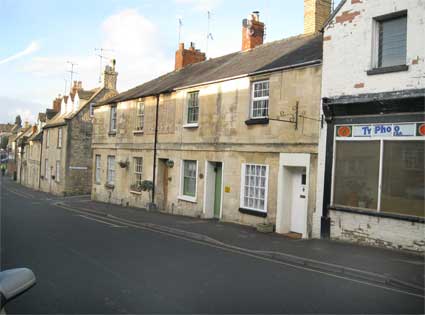 2013 images
2013 images'NORTH STREET
BREWERY'
BREWERY'
There are curlicues decorating
this obliterated sign in North Street, presumably the rain downpipe is
a later addition. We cannot trace any information about this former
brewery.

Gloucester Street
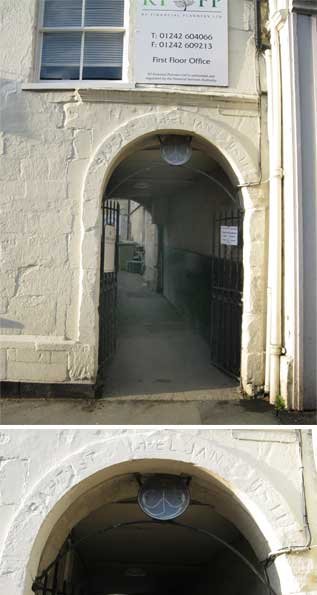
'BAPTIST CHAPEL JAN 1 1811'
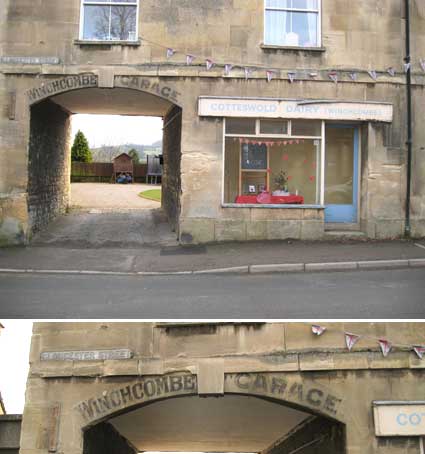
This Chapel was founded in 1811,
though it is now closed, but it is not known when. Mentioned in Non-Conformist Chapels and Meeting Houses,
Gloucestershire (1986) where it is described as on the north
side of the street, and "approached through a passage with semicircular
arch at the south end inscribed 'Baptist Chapel Jan 1 1811' ... the
church appears to have united with Congregationalists about 1878 when
Union Chapel was built although a separate Baptist congregation may
have resulted from the merger and continued to meet here".
This is appears to have been the case at least until 1923, as Kelly's Directory of that year lists both a Baptist Chapel founded in 1811, with seats for 150, and the Union Chapel, founded in 1878. The Union Chapel referred to is in Gretton Road, and is now Cotswold Christian Centre, but the former Baptist Chapel is now in secular use. The space after 'JAN' is a puzzle: it is too large for a mere '1', surely? It has had filler roughly slapped over it.
This is appears to have been the case at least until 1923, as Kelly's Directory of that year lists both a Baptist Chapel founded in 1811, with seats for 150, and the Union Chapel, founded in 1878. The Union Chapel referred to is in Gretton Road, and is now Cotswold Christian Centre, but the former Baptist Chapel is now in secular use. The space after 'JAN' is a puzzle: it is too large for a mere '1', surely? It has had filler roughly slapped over it.

'WINCHCOMBE GARAGE'
Opposite the church on Gloucester Street. The different fonts
used either side of the keystone are intriguing: condensed serif'd caps
on the left and heavier, fatter sans-serif to the right; perhaps it was
just a matter of the signwriter filling the available spaces.
Winchcombe Garage still appears to trade from other premises in the
town. Cottteswold Dairy (Winchcombe) was founded in 1938 and is based
in Tewkesbury. The metal street name, rather pale, is: Gloucester
Street.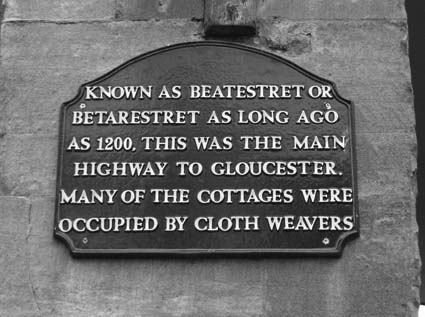
This was one of several informative plaques to be found in Winchcombe, but when these photographs were taken in February 2013, the plaque had been removed from its position to the left of the archway.
'KNOWN AS BEATESTRET OR
BETARESTRET AS LONG AGO
AS 1200, THIS WAS THE MAIN
HIGHWAY TO GLOUCESTER.
MANY OF THE COTTAGES WERE
OCCUPIED BY CLOTH WEAVERS'
BETARESTRET AS LONG AGO
AS 1200, THIS WAS THE MAIN
HIGHWAY TO GLOUCESTER.
MANY OF THE COTTAGES WERE
OCCUPIED BY CLOTH WEAVERS'
Below: there is a CTC 'winged wheels' painted metal sign on the wall of the 16th century coaching inn, The White Hart in High Street. A similar sign can be found in Upper Brook Street, Ipswich – see that page for an explanation. Similar examples can be seen in Dent, Yorkshire and Barnards Farm, Essex (shown on the same page). The contrasting painted elements, although a little degraded, are in sad contrast to the Ipswich example, now covered in masonry paint. Another excellent 'Headquarters' example of the 'Winged wheel' CTC sign can be found on a former inn in Sturminster Newton, Dorset.
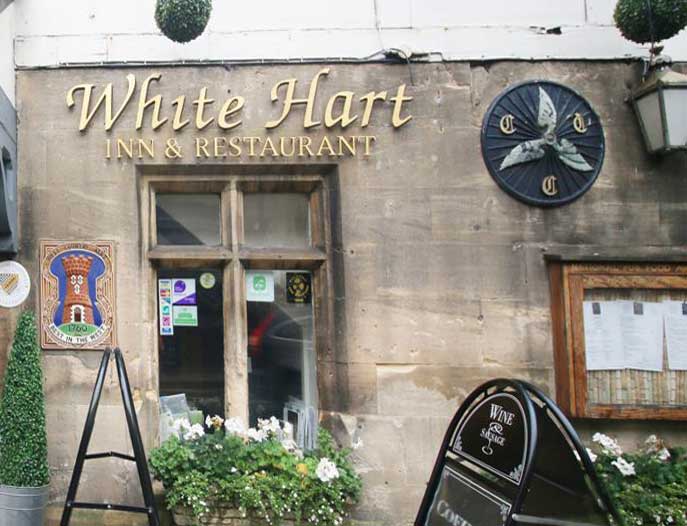
Upton-Upon-Severn
Upton-upon-Severn is situated on the west bank of the River Severn and is located five miles south-east of Malvern. Until the latter half of the 20th century, the bridge at Upton was the only one across the River Severn between Worcester and Tewkesbury. Like Tewkesbury, Upton has a Ham: a large, low-lying water meadow. Oliver Cromwell's soldiers crossed the Severn here to win the Battle of Upton in 1651 before the main Battle of Worcester in the English Civil War. The present bridge was built in 1940. Anyone observing the Severn here will know that it is a powerful, dangerous river; Upton is known for its regular flooding (scrolldown for more on flooding).
9 New Street
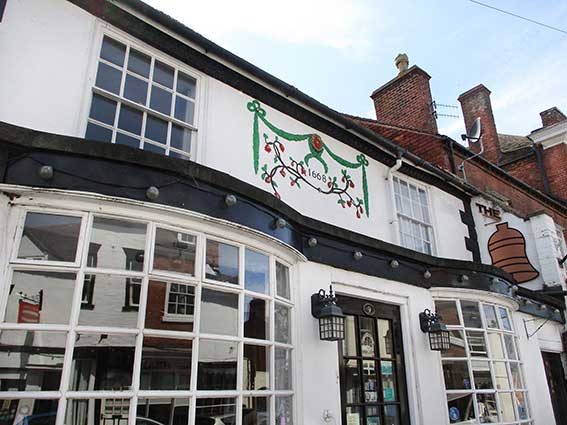
'1668'
in painted pargetting. This was eight years after the
Restoration of Charles II to the throne and only two since the Fire of
London.Old Fire Station, 20 New Street
An unusual looking building and big enough for just one fire engine, now residential. It retains its fire practice tower as part of the house.
'FIRE ENGINE STATION'
is rather beautifully carved in
the stone lintel in serif'd condensed capitals.
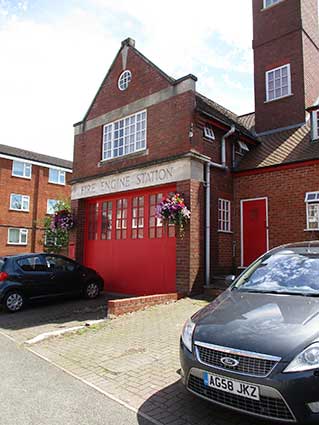
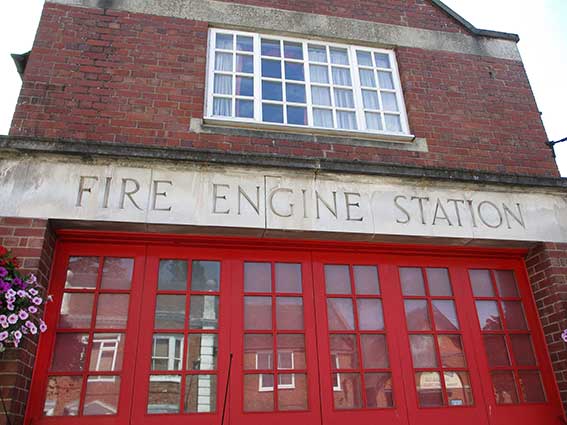 2020 images
2020 images18-20 New Street
New Street has a variety of architecture, for example this frontage sporting ball finials.

Listed Grade II: 'Mid to later C18 red brick formal refronting of a C17 range. Two double fronted houses. Two-storey. Plain tile roofs, higher pitched to right with small dormer. Each house 3 window range with painted stone rusticated angle dressings. High parapet divided by stucco strips with ball finials. Modillion bracket cornice breaking forward over angle dressings and around window bays. Two 2-storey splayed bays with exposed box sliding windows. Central 1st floor window, in eared architrave with sill course carried across side bays to No 18. Architrave and sill course removed on No 20. Circular central attic window in parapet of No 18. Fine doorcases with open pediments on brackets around round headed openings with fanlights. Fanlight tracery, side panels and 6-panel door service on No 18 only. Sill course between ground floor bays. No 18 is wider than No 20.'
Shipps Garage, 22 New Street
'SHIPPS' is strikingly painted in white caps with a red drop shadow on the black folding doors.
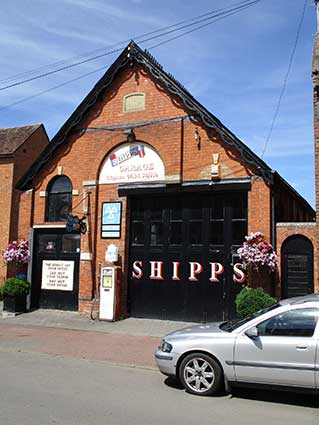
Shipps Garage was a former nonconformist chapel erected in 1891. A few yards down the road stand large flood defences and massive, insulated steel doors which can be closed across the road to protect the town.
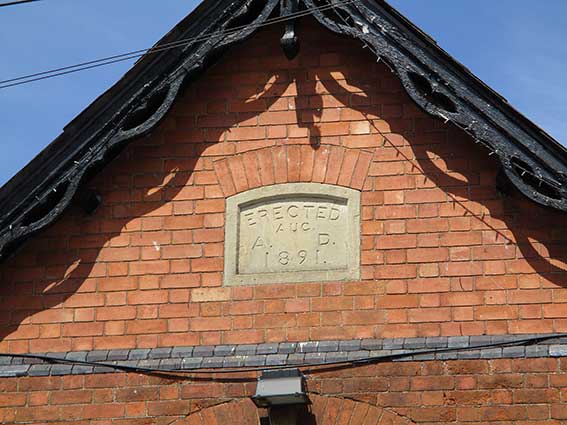
A small plaque reads 'ESTABLISHED 1926'. An old style petrol pump is a feature of the street furniture here. The pump has a clock-style meter showing the number of gallons delivered. A pump of similar vintage can be seen at Ruskin Lifting Engineers in Foxhall Road, Ipswich.

The hand reading ‘POWER ETHYL’ is attributed to the renowned graphic artist Edward McKnight Kauffer. The hand logo of Power Ethyl (petrol), was introduced in 1935 by Shell-Mex BP. Although Shell-Mex had taken over the Power Petroleum Company in 1934, the 'Power' brands and identities were maintained.
The pump has boasted a lozenge-shaped, electrically-lit globe bearing the words ‘CLEVELAND DISCOL’ (with ‘ALCOHOL’ spelt out vertically down the side. Cleveland Discol was an alcohol-based vehicle fuel belonging to the Petroleum Storage and Finance Corporation based in Cleveland in the north-east of England. It was a popular brand of British petrol between the 1930s and 1960s and was marketed as a 'superior petrol' due to its potent blend of distilled alcohol (ethanol) and refined petrol. However, it appears from these images that the proprietor changes the globe from time to time. Here also is the familiar ‘SHELL’ branding.


Close to the pump is a blue diamond showing:
‘FLOOD LEVEL
22 - 7 - 07’
Flooding22 - 7 - 07’
A few yards down the road stand large flood defences and massive, insulated steel gates which can be closed across the road to protect the town. They were installed in 2011.

The River Severn brings trade and visitors but also imperils the town. Low-lying areas in Uprton suffered serious flooding in 2000. However, in the 2007 floods, levels exceeded those in 2000, and the town was inaccessible by road. Upton’s main built-up area lies on slightly higher ground than the surrounding countryside, and becomes an island during severe floods, much as happens to the land around Tewkesbury Abbey.
Close to the river bridge in High Street is a set of cast iron flood markers:
’NOV 14TH
– FLOOD LEVEL –
1852’
‘MAY 5TH
– FLOOD LEVEL –
1886’
‘FLOOD LEVEL
1947’
– FLOOD LEVEL –
1852’
‘MAY 5TH
– FLOOD LEVEL –
1886’
‘FLOOD LEVEL
1947’
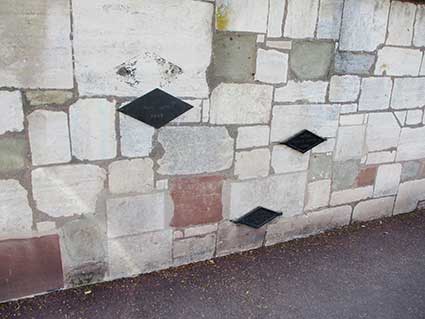
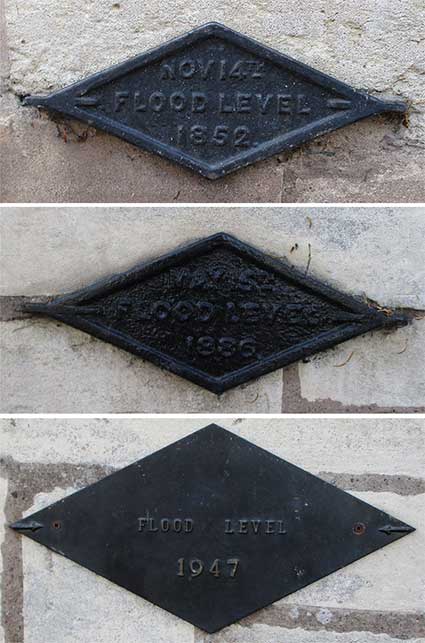
It is interesting to note that the 1947 diamond-shaped plate – the highest flood level recorded on this wall – has the marks of another plate above it. Was it affixed in error, then lowered? The 1852 plate is the nearest to the pavement level.
The Pepperpot
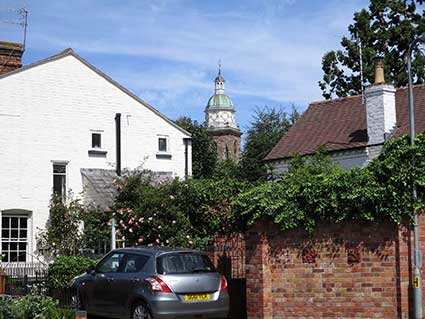
Next to the bridge over the Severn is the site of the original church, or rather what remain of it: the tower known as The Pepperpot. The distinctive medieval church tower topped by an 18th Century cupola in place of a spire, is visible from almost all over Upton on Severn. This was the original Parish Church but is now the home of the Upton Tourist Information and Heritage Centre. Only the lower part of the tower remains from the 14th century Gothic church. The original nave was demolished and the spire pulled down in the mid-18th century when the nave was rebuilt and the spire replaced by the Italianate cupola (the 'Pepperpot') seen today.
21 High Street, The White Lion Hotel
The White Lion Hotel is a coaching inn, with sections of the building dating to 1510. Reputed to have seen soldiers from both sides of the Civil War enjoying its hospitality prior to the Battle of Worcester. Henry Fielding the famous dramatist, journalist and author, who based his books on friends and colleagues, stayed at The White Lion in Upton upon Severn and in 1749 wrote of The White Lion in The History of Tom Jones, ‘Tom took … his redeemed lady … to that Inn, which in their eyes presented the fairest appearance in the street’ and he called the hotel ‘a house of exceedingly good repute’. He also mentions The Rose Room and The Wild Goose Room, both of which remain in use today.

The frontage boasts five pilasters and a portico projects over the pavement, supported by two Doric pillars. The statue of a rather melancholy-looking lion staues atop with his front paw on a sphere. Behind the lion is a metal bracket carrying a cut-out Art Deco white lion with his paw appropriately on the wrought iron curlicue, the whole supporting a period Automobile Association 'Hotel' sign. The winged circle enclosing the interlaced 'AA' was used in variants from 1906 to 1967.
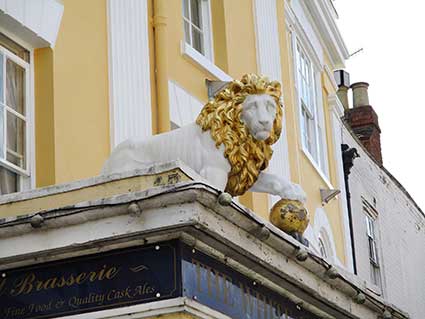
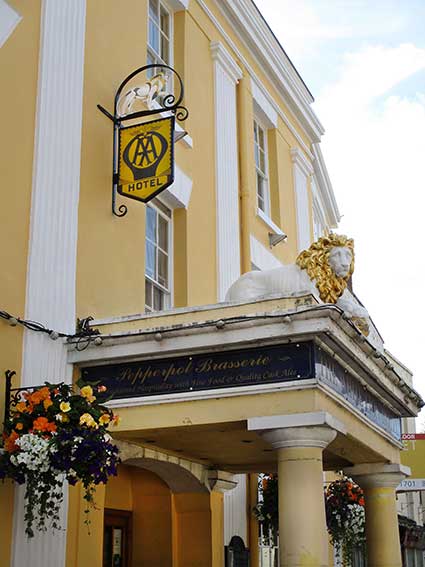
12 High St, chemist's shop
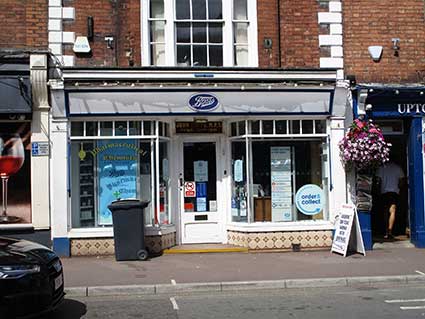
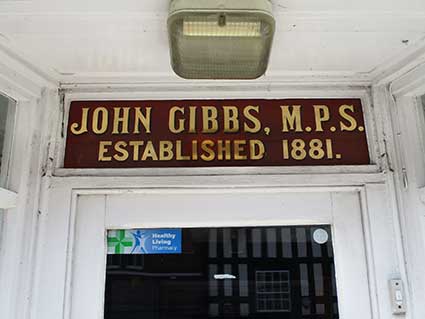
On the other side of the road to the White Lion is a chemist's shop with preserved gold mirrored lettering above the door:
ESTABLISHED 1881’
Although Mr Gibbs is long gone,
the shop remains as a chemist's today.
13 High Street
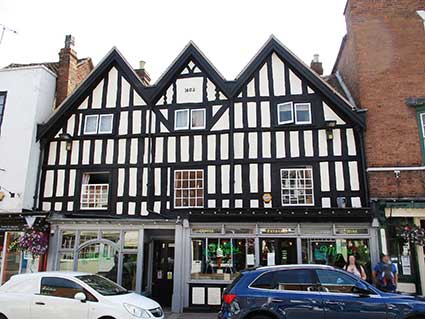
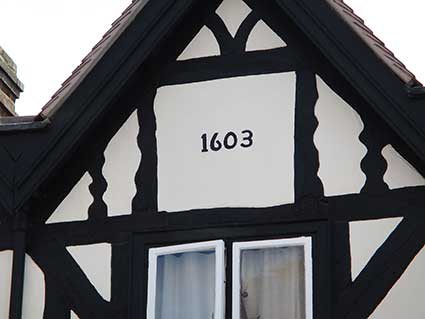
The Grade II Listing text reads: '1603 (painted date) large timber-framed house. Two-storey and attic. Plain tile roof. Three gabled front. Three window range. Close-set vertical studding. Renewed moulded bargeboards. Casements to attic with painted date 1603 in centre gable. Glazing bar sashes to first floor. C19 and modern shopfronts below. Two storey gabled rear extension; part painted brick part exposed timber.'
5-7 High St
Neither of these adjacent buildings are listed. They both bear the date '1601'.
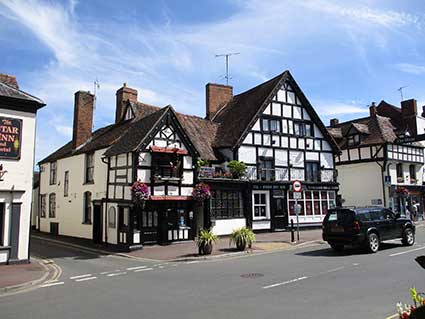
'Ye Olde Anchor Inn' is on the left (no. 5) and it covers itself by displaying 'circa 1601' on the stucco above the ground floor. The larger building is an Indian restaurant (no. 7). It is possible that the timber framing within the building (or part of it) dates back to 1601 and the facades are more recent. The degree of change in the building may impede listing.
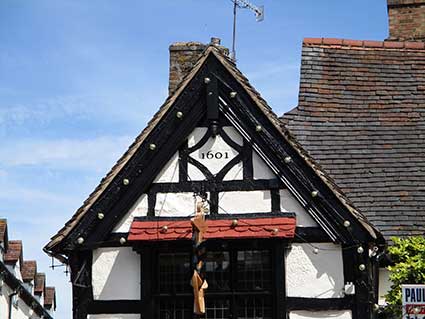
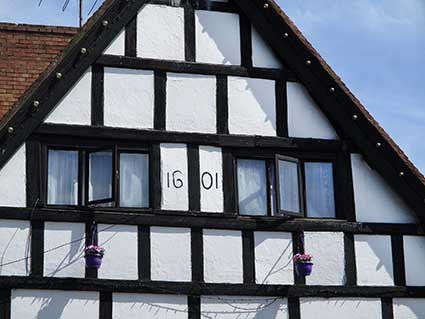
16 Old Street, former Post Office
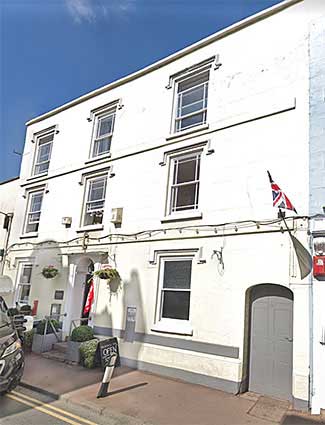
The building is still in use by at least one commercial company, however, it still bears the evidence of its former use.
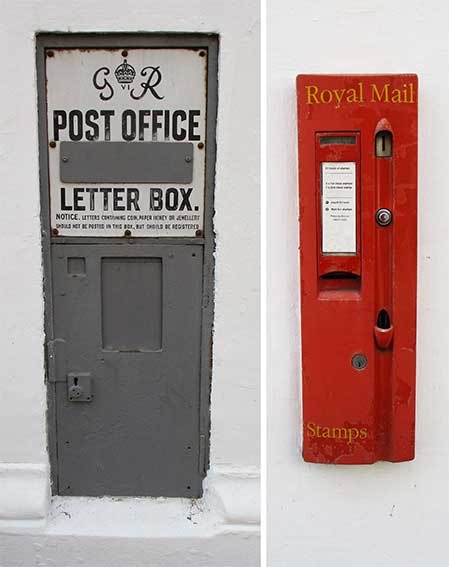
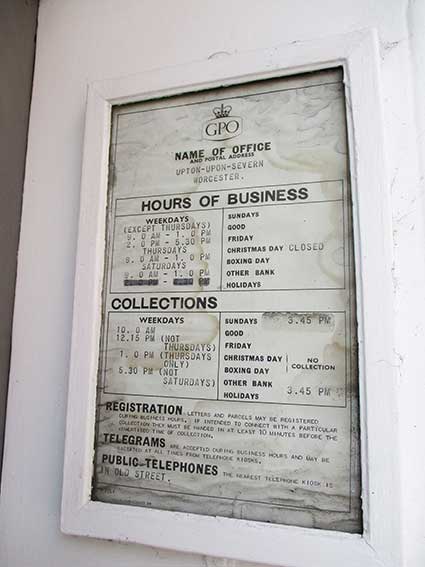
13 High Street


The Grade II Listing text reads: '1603 (painted date) large timber-framed house. Two-storey and attic. Plain tile roof. Three gabled front. Three window range. Close-set vertical studding. Renewed moulded bargeboards. Casements to attic with painted date 1603 in centre gable. Glazing bar sashes to first floor. C19 and modern shopfronts below. Two storey gabled rear extension; part painted brick part exposed timber.'
5-7 High St
Neither of these adjacent buildings are listed. They both bear the date '1601'.

'Ye Olde Anchor Inn' is on the left (no. 5) and it covers itself by displaying 'circa 1601' on the stucco above the ground floor. The larger building is an Indian restaurant (no. 7). It is possible that the timber framing within the building (or part of it) dates back to 1601 and the facades are more recent. The degree of change in the building may impede listing.


16 Old Street, former Post Office

The building is still in use by at least one commercial company, however, it still bears the evidence of its former use.


‘Royal Mail
£1 book of stamps
-
3 x 1st class stamps
1 x 2nd class stamps
-
1. Insert coin
2. Wait for stamps
Press button to return coin
Stamps’
‘G VI R
POST OFFICE
LETTER BOX.
NOTICE. LETTERS CONTAINING COIN, PAPER MONEY OR JEWELLERY
SHOULD NOT BE POSTED IN THIS BOX, BUT SHOULD BE REGISTERED.’
£1 book of stamps
-
3 x 1st class stamps
1 x 2nd class stamps
-
1. Insert coin
2. Wait for stamps
Press button to return coin
Stamps’
The condition of this wall stamp
machine, from which one bought 'a book of stamps' (they were originally
little books full of gummed stamps and adverts) suggests that the
machine still works. Surely the coin slot would have been blocked up
(see the adjacent wall box) and the instructions removed. However, on
closer inspection, we read an almost indecipherable 'NOT IN USE' in the
top window.
‘G VI R
POST OFFICE
LETTER BOX.
NOTICE. LETTERS CONTAINING COIN, PAPER MONEY OR JEWELLERY
SHOULD NOT BE POSTED IN THIS BOX, BUT SHOULD BE REGISTERED.’
George VI reigned from 1936 until
his death in 1952; he is the father of Queen Elizabeth II. The cursive
'GR': for royal initials on post boxes, different letterforms were used
for each reign. Royal Mail customarily blocks the letter slot of
defunct boxes and paints them grey or black (see the example in
Woodbridge Road, Ipswich on our Street
furniture page). The plate with its integral letter slot has been
left unpainted, so we see wear and tear on the lettering above and
below the slot where thousands of hands have posted mail over many
years.
23 Old Street
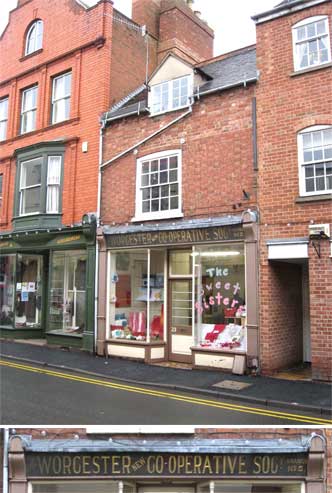 2013
images
2013
images
'THE WORCESTER NEW
CO-OPERATIVE SOCY
BRANCH NO. 5'
BRANCH NO. 5'
No
longer a Co-op (that's a few doors away to the left) but a shop that
preserves the past by revealing this lovely old Co-op sign in gold
condensed capitals; the small tilted 'THE and 'NEW', the superior 'Y'
floating above a dot and the 'BRANCH No. 5' are a joy. One can only ask
if there was an 'old' Co-op in Upton, or was this an early branch of a
newly formed Co-op when the movement was young. This tiny shop with its
classy sign is a signifier of the huge national movement which was to
follow.

Upton's local historian (see http://www.upton.uk.net/history/coop.html) tells us that The Worcester Co-operative Society was founded in March 1881. In June 1901, after pressure from their existing members in Upton, the committee was persuaded to open the Society's fifth branch: it was on the west side of Old Street and was in premises which were leased for three years. Members increased: in one month over sixty joined from Upton. In the first year's trading there was a turnover of £1,480 at the Upton branch with £132 being returned to members as dividends. In June 1904 the new shop was opened with a flourish. The steamer The Duchess of York was hired for £6.6s.0d. to bring the visitors from Worcester, the band played and Mr Roy, a long serving member of the Committee who performed the opening ceremony, was presented with a silver gilt key. The outside of the shop was redecorated in 1906 by G. H. Price for the sum of £3.9s.Od., and in 1909 he also repainted the sign for £1.7s.6d. This is probably the sign which can be seen today. By October 1926 the Co-op activities were concentrated in larger premises a few doors away and No. 23, although considered as a Co-op pharmacy, was eventually sold.
39 Old Street
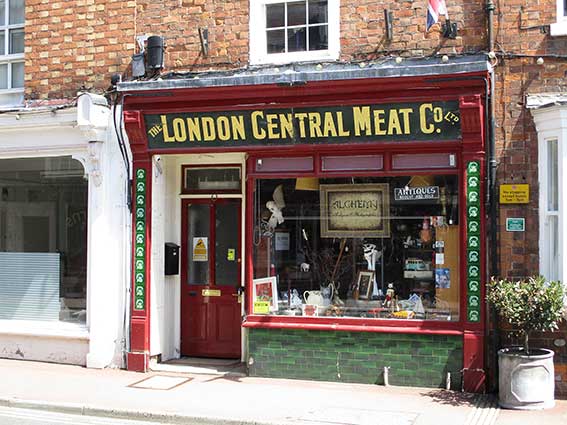
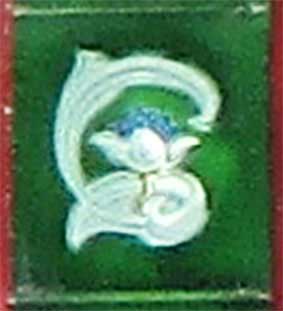 2020 images
2020 images
This shop-front has had a number of recent uses, but preserves the original, rather industrial-sounding name. The London Central Meat Company story starts way back in 1880 when a meat stall was set up on Tamworth market. The London Central Meat Co. started in the 1890s in Tamworth by a Mr Lea & a Mr Lowe. They eventually opened about to 440 shops in England dealing in home-killed & imported meat. In 1964 they changed the name to Baxters after the then chairman Arthur Baxter, who had married Mr Lea’s daughter. Baxters had abattoirs/depots in Gloucester & Northampton & depots in Chester, Southampton. Bought and sold from 1974, eventually (under the Dewhurst branding) the company ended in receivership in 1995. (Norman Finnimore, the Meat Trade Historian)
The ceramic tile surround with its Art Nouveau motif and the green ceramic store-riser (the solid section at the base of a shop window), and awning stowed at the top make for a very pleasing shop-front. There are decorative floor tiles at the entrance.
 Period photograph of a typical branch.
Period photograph of a typical branch.
42(?) Old Street

Upton's local historian (see http://www.upton.uk.net/history/coop.html) tells us that The Worcester Co-operative Society was founded in March 1881. In June 1901, after pressure from their existing members in Upton, the committee was persuaded to open the Society's fifth branch: it was on the west side of Old Street and was in premises which were leased for three years. Members increased: in one month over sixty joined from Upton. In the first year's trading there was a turnover of £1,480 at the Upton branch with £132 being returned to members as dividends. In June 1904 the new shop was opened with a flourish. The steamer The Duchess of York was hired for £6.6s.0d. to bring the visitors from Worcester, the band played and Mr Roy, a long serving member of the Committee who performed the opening ceremony, was presented with a silver gilt key. The outside of the shop was redecorated in 1906 by G. H. Price for the sum of £3.9s.Od., and in 1909 he also repainted the sign for £1.7s.6d. This is probably the sign which can be seen today. By October 1926 the Co-op activities were concentrated in larger premises a few doors away and No. 23, although considered as a Co-op pharmacy, was eventually sold.
39 Old Street
'THE LONDON
CENTRAL MEAT CO. LTD.'
The large and small caps in a
condensed letterform echo the nearby Co-op's smaller and tilted 'THE'
and 'LTD.' It does appear that the gold lettering has either been
painted over in black (now largely removed), or another sign has at one
time been glued over it – traces of black can still be seen.

 2020 images
2020 imagesThis shop-front has had a number of recent uses, but preserves the original, rather industrial-sounding name. The London Central Meat Company story starts way back in 1880 when a meat stall was set up on Tamworth market. The London Central Meat Co. started in the 1890s in Tamworth by a Mr Lea & a Mr Lowe. They eventually opened about to 440 shops in England dealing in home-killed & imported meat. In 1964 they changed the name to Baxters after the then chairman Arthur Baxter, who had married Mr Lea’s daughter. Baxters had abattoirs/depots in Gloucester & Northampton & depots in Chester, Southampton. Bought and sold from 1974, eventually (under the Dewhurst branding) the company ended in receivership in 1995. (Norman Finnimore, the Meat Trade Historian)
The ceramic tile surround with its Art Nouveau motif and the green ceramic store-riser (the solid section at the base of a shop window), and awning stowed at the top make for a very pleasing shop-front. There are decorative floor tiles at the entrance.
 Period photograph of a typical branch.
Period photograph of a typical branch.42(?) Old Street
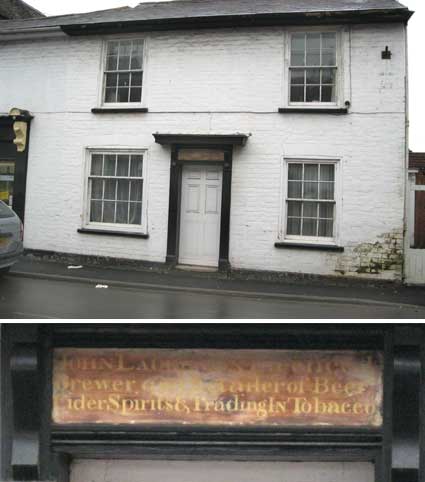 2013
images
2013
images
'JOHN LAUGHTON[?] Licenced
Brewer and Retailer of Beer
Cider Spirits & Trading in Tobacco'
Brewer and Retailer of Beer
Cider Spirits & Trading in Tobacco'
This
anonymous,
unnumbered, double-fronted house on the street out of Upton bears a
fugitive licencing sign showing that it was once a public house and
brew house.
46 Old Street
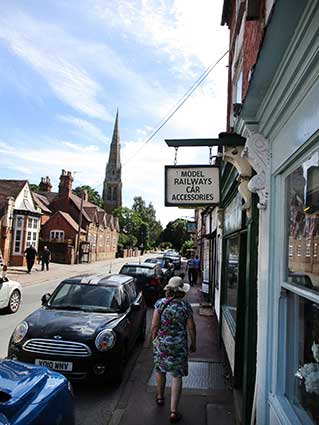
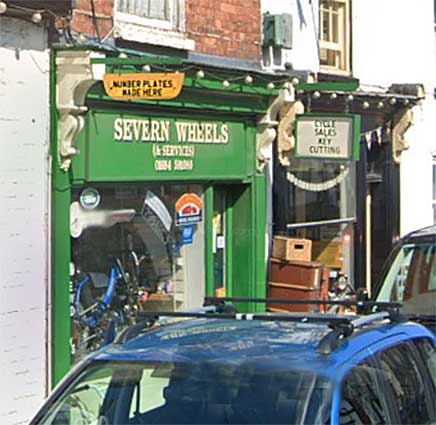 2020 images
2020 imagesSevern Wheels (& Services) boast a plethora of trades. Projecting signs read:
'MODEL
RAILWAYS
CAR
ACCESSORIES'
'CYCLE
SALES
KEY CUTTING'
'NUMBERPLATES
MADE HERE'
RAILWAYS
CAR
ACCESSORIES'
'CYCLE
SALES
KEY CUTTING'
'NUMBERPLATES
MADE HERE'
'WE BUY OLD TOYS' is displayed in
the shop window. In the background the Parish Church of St Peter &
St Paul – the church which replaced the Pepperpot near to the river
bridge – shows its impressive spire.
58 Old Street
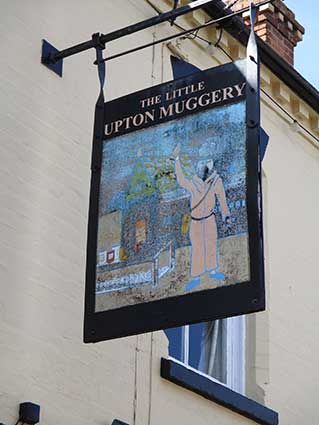
Little Upton Muggery is one of the surviving pubs from the 'Little' chain – a real old-fashioned tavern. Appropriately, the interior is decorated with hundreds of ceramic mugs.
Waterside
As a prime example of the wealth of architecture in Upton, take a walk by the river towards the Ham.
58 Old Street

Little Upton Muggery is one of the surviving pubs from the 'Little' chain – a real old-fashioned tavern. Appropriately, the interior is decorated with hundreds of ceramic mugs.
Waterside
As a prime example of the wealth of architecture in Upton, take a walk by the river towards the Ham.
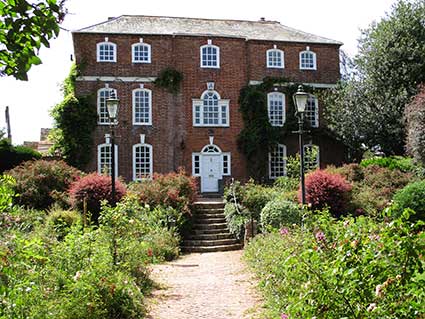
Home
Return to Historic Lettering from outside IpswichPlease email any comments
and contributions by clicking here.
Search Ipswich Historic Lettering
Return to Historic Lettering from outside Ipswich
Search Ipswich Historic Lettering
©2004 Copyright
throughout the Ipswich
Historic Lettering
website: Borin Van Loon
No reproduction of text or images without express written permission
No reproduction of text or images without express written permission